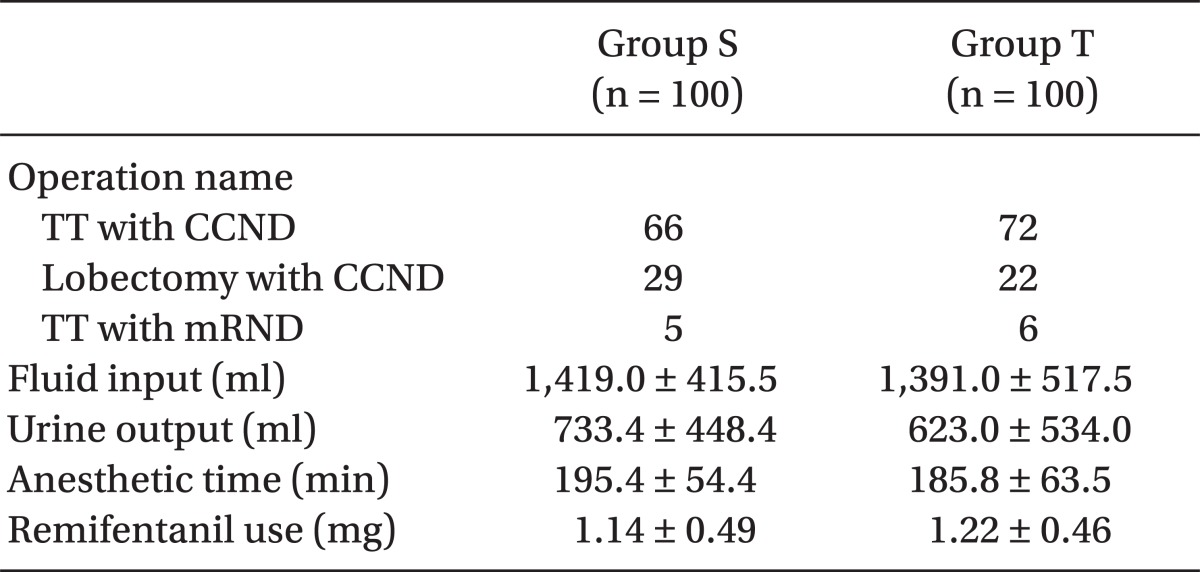1. Tramer M, Moore A, McQuay H. Meta-analytic comparison of prophylactic antiemetic efficacy for postoperative nausea and vomiting: propofol anaesthesia vs omitting nitrous oxide vs total i.v. anaesthesia with propofol. Br J Anaesth. 1997; 78:256–259. PMID:
9135300.
2. O'Connor CJ, Rothenberg DM, Tuman KJ. Miller RD, editor. Anesthesia and the hepatobiliary system. Miller's Anesthesia. 2010. 7th ed. Philadelphia: Elsevier Churchill Livingstone;p. 2135–2149.
3. Jung BH, Chung MH, Lee SW, Won LS. Acute hepatitis after general anesthesia in a child. Korean J Anesthesiol. 1995; 28:467–471.

4. Modesti C, Sacco T, Morelli G, Bocci MG, Ciocchetti P, Vitale F, et al. Balanced anesthesia versus total intravenous anesthesia for kidney transplantation. Minerva Anestesiol. 2006; 72:627–635. PMID:
16865081.
5. Sahin SH, Cinar SO, Paksoy I, Sut N, Oba S. Comparison between low flow sevoflurane anesthesia and total intravenous anesthesia during intermediate-duration surgery: effects on renal and hepatic toxicity. Hippokratia. 2011; 15:69–74. PMID:
21607040.
6. Yoon JH, Cho SH, Kim CS, Ahn KR, Kwon JH, Kang KS, et al. Comparisons of propofol, enflurane, sevoflurane, and desflurane anesthesia in laparoscopic cholecystectomy on postoperative liver enzyme levels. Korean J Anesthesiol. 2005; 49:18–24.

7. Mihm FG. Jaffe RA, editor. Endocrine surgery. Anesthesiologist's manual of surgical procedures. 2009. 4th ed. Philadelphia: Lippincott Williams & Wilkins;p. 658–659.
8. Bhattacharyya N, Fried MP. Assessment of the morbidity and complications of total thyroidectomy. Arch Otolaryngol Head Neck Surg. 2002; 128:389–392. PMID:
11926912.

9. Oh SW, Koo GH, Kim SJ, Woo YC. Comparison of propofol with enflurane anesthesia in laparoscopic cholecystectomy for the change of liver function. Korean J Anesthesiol. 1999; 36:279–285.

10. Ogawa M, Doi K, Mitsufuji T, Satoh K, Takatori T. Drug induced hepatitis following sevoflurane anesthesia in a child. Masui. 1991; 40:1542–1545. PMID:
1766104.
11. Park JT, Lee YB, Kim JS, Ryu H, Lim HK. Acute liver injury after sevoflurane anesthesia: a case report. Korean J Anesthesiol. 2009; 57:221–224.
12. Kneiseler G, Bachmann HS, Bechmann LP, Dechene A, Heyer T, Baba H, et al. A rare case of propofol-induced acute liver failure and literature review. Case Rep Gastroenterol. 2010; 4:57–65. PMID:
21103229.

13. Mazze RI, Callen CM, Galvez ST, Delgado-Herrera L, Mayer DB. The effects of sevoflurane on serum creatinine and blood urea nitrogen concentration: a retrospective, twenty-two-center, comparative evaluation of renal function in adult surgical patients. Anesth Analg. 2000; 90:683–688. PMID:
10702457.
14. Iyer RA, Anders MW. Cysteine conjugate beta-lyase-dependent biotransformation of the cysteine S-conjugates of the sevoflurane degradation product compound A in human, nonhuman primate, and rat kidney cytosol and mitochondria. Anesthesiology. 1996; 85:1454–1461. PMID:
8968194.
15. Eger EI 2nd, Koblin DD, Bowland T, Ionescu P, Laster MJ, Fang Z, et al. Nephrotoxicity of sevoflurane versus desflurane anesthesia in volunteers. Anesth Analg. 1997; 84:160–168. PMID:
8989018.

16. Tung A, Jacobsohn E. A case of nonoliguric renal failure after general anesthesia with sevoflurane and desflurane. Anesth Analg. 1997; 85:1407–1409. PMID:
9390618.

17. Fukuda K. Miller RD, editor. Opioids. Miller' Anesthesia. 2010. 7th ed. Philadelphia: Churchill Livingstone;p. 797.

18. Morgan GE Jr, Mikhail MS, Murray MJ. Clinical anesthesiology. 2006. 4th ed. New York: McGraw-Hill companies;p. 743.
19. Kharasch ED, Frink EJ Jr, Zager R, Bowdle TA, Artru A, Nogami WM. Assessment of low-flow sevoflurane and isoflurane effects on renal function using sensitive markers of tubular toxicity. Anesthesiology. 1997; 86:1238–1253. PMID:
9197292.

20. Moore E, Bellomo R, Nichol A. Biomarkers of acute kidney injury in anesthesia, intensive care and major surgery: from the bench to clinical research to clinical practice. Minerva Anestesiol. 2010; 76:425–440. PMID:
20473256.
21. Kim H, Xu M, Lin Y, Cousins MJ, Eckstein RP, Jordan V, et al. Renal dysfunction associated with the perioperative use of diclofenac. Anesth Analg. 1999; 89:999–1005. PMID:
10512279.

22. Fontana RJ, Shakil AO, Greenson JK, Boyd I, Lee WM. Acute liver failure due to amoxicillin and amoxicillin/claculanate. Dig Dis Sci. 2005; 50:1785–1790. PMID:
16187174.
23. Fritz G, Barner C, Schindler R, Boemke W, Falke K. Amoxicillininduced acute renal failure. Nephrol Dial Transplant. 2003; 18:1660–1662. PMID:
12897111.







 PDF
PDF Citation
Citation Print
Print




 XML Download
XML Download